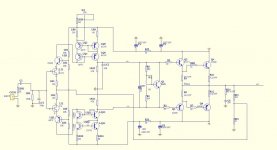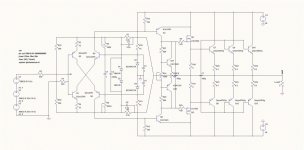Yes, sure, this is more or less the quintessential com.diff. structure. I would use the laterals at the output driving the speaker with the drains though. You will observe better stability with a speaker load. Lazy Cat mentioned that in his thread at the beginning when his amp was still simple. I mentioned that several times too but it went unrecognized.
What i really need is a little 25W class A amp so we could open a thread " Simple Class A amp with laterals in common source configuration ". What do you think.
What i really need is a little 25W class A amp so we could open a thread " Simple Class A amp with laterals in common source configuration ". What do you think.
I think that the simple lazy-cat is already there...
I have made PCB's for a scaled version..with Transistor current dumping ala Adyton for the output...plan on running it at 56 V rails, Get 10 PCB's this coming week.....could be possible to tweak the PCB a bit.. and cut off the current dumping part..Then your 30 W is there...
but driving from the drain is surely interesting..
I have made PCB's for a scaled version..with Transistor current dumping ala Adyton for the output...plan on running it at 56 V rails, Get 10 PCB's this coming week.....could be possible to tweak the PCB a bit.. and cut off the current dumping part..Then your 30 W is there...
but driving from the drain is surely interesting..
Last edited:
Fine, you are a busy man. That could be something for me. Could you post the circuit diagram again here ? That other thread got me confused.
Tonight i put the PEN circuit in my system. The only thing i can say is that it plays music and it is low noise. I can listen only quiet at this time in the night and after a lot of component swapping i have some trouble on one channel of my resident MM phono stage.
I will sort it out tomorrow.
I will sort it out tomorrow.
Hi Joachim.. Been fiddling around with the drain tapped poweramp...an can't seem to get i working properly...well it seems like all working points are looking nice.. current in the output fully adjustable..running a nice current (5mA) in the input cascode....But performance is really bad with 2.5% distortion even at low swings...
Will have to look more into this.. Why do you want to take the signal off the Drain..??
I mean the speaker return currents has other ways into the amplifier than though the internal mosfet-diodes...here it runs right into the feedback network..
Will have to look more into this.. Why do you want to take the signal off the Drain..??
I mean the speaker return currents has other ways into the amplifier than though the internal mosfet-diodes...here it runs right into the feedback network..
Maybe this idea to go out the drains does not work with Lazy Cats input stage. I would prefer that connection because of simplicity. Also a lateral Fet is a very good constant current source. I am concerned about the stability of the amp into a complex load. I see here many amps that have THD of less then 0.001% simulated or measured on a dummy load so this problem is solved. For example the TMC blameless that was published in Linear Audio 1. It uses only a few parts and is cheep to make. So why should we design another amplifier ? Self is the champion on low TDH versus cost already. Connected to a real speaker things are not so rosy any more. Anyway Michael, go ahead and design something that works for you. I am curious to investigate it.
The PEN circuit is now working in Stereo. I had an offset problem on one channel of my MM stage. It was caused by a small uninsulated copper wire that was conecting Pin 4 to Pin 3 of my JG-Self MM. The PEN is quiet. I will do more listening today.
I personally think that a mosfet amplifier driving some sets of Bipolar current dumpers is a good way to deal with complex loads,, let en bjt's do the crude current work and then let the fine lateral mosfet amplifier deal with the finer voltage adjustments..this way I believe we can get the best of both worlds...
This is where a am right now....I have made a PCB..And will start to assemble when I have the last components here....It's basically an elaboration on Nico's take on Lazycats circuit...Show's some promise I think..
Attachments
Last edited:
Looks good to me. Nice transistors choosen. That in class a could be what i am searching for.
In the meantime i have being working on the PEN circuit a bit more. It sounds very good so i can recommend it as a quick fix. What came to my mind is an AIOG RIAA based on that but with a floating cascode input. i will draw something up and try it.
In the meantime i have being working on the PEN circuit a bit more. It sounds very good so i can recommend it as a quick fix. What came to my mind is an AIOG RIAA based on that but with a floating cascode input. i will draw something up and try it.
and very very good in distortion specter....The pcb I have made is without the bias network...as I have a feeling that a pure resistor-bias is enough to keep it thermally stable...as the negative temp-co of the laterals has a higher slope than the output btj's..If not Ill have to hard-wire it...
You will find out, sure.
Here is my AIOG PEN circuit. It looks a bit exotic even for me but it should work. The input stage is now my well known buffer, inverted and without the trimming resistors. I named the circuit Starless and Bible Black due to an article that Malkolm Hawksford wrote and is also a name of a Robert Fripp album.
The precision mirror has excellent DC stability so i hope i can use it without servo. The circuit is fully floating and needs a supply with one polarity only. If it works i plan to make a PCB this time.
Here is my AIOG PEN circuit. It looks a bit exotic even for me but it should work. The input stage is now my well known buffer, inverted and without the trimming resistors. I named the circuit Starless and Bible Black due to an article that Malkolm Hawksford wrote and is also a name of a Robert Fripp album.
The precision mirror has excellent DC stability so i hope i can use it without servo. The circuit is fully floating and needs a supply with one polarity only. If it works i plan to make a PCB this time.
Attachments
interesting with the GND reference... good way to get DC-coupling......looks like an interesting concept..temp-co could give some DC float
It could be made all SMD..with the BF parts. small and compact..
It could be made all SMD..with the BF parts. small and compact..
Last edited:
You will find out, sure.
Here is my AIOG PEN circuit. It looks a bit exotic even for me but it should work. The input stage is now my well known buffer, inverted and without the trimming resistors. I named the circuit Starless and Bible Black due to an article that Malkolm Hawksford wrote and is also a name of a Robert Fripp album.
The precision mirror has excellent DC stability so i hope i can use it without servo. The circuit is fully floating and needs a supply with one polarity only. If it works i plan to make a PCB this time.
Hi Joachim
Clever circuit. 🙂
The mirrors can of course be improved a bit, I know that you can make them better.

Cheers
Stein

